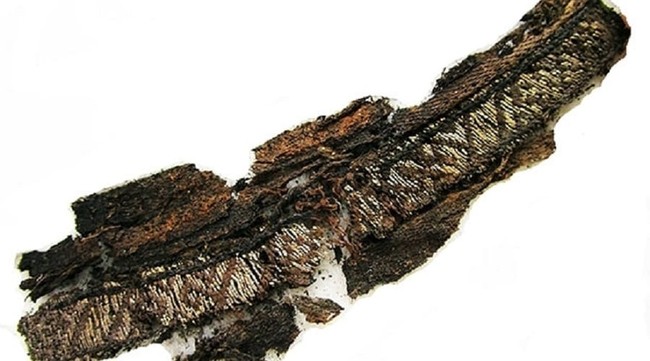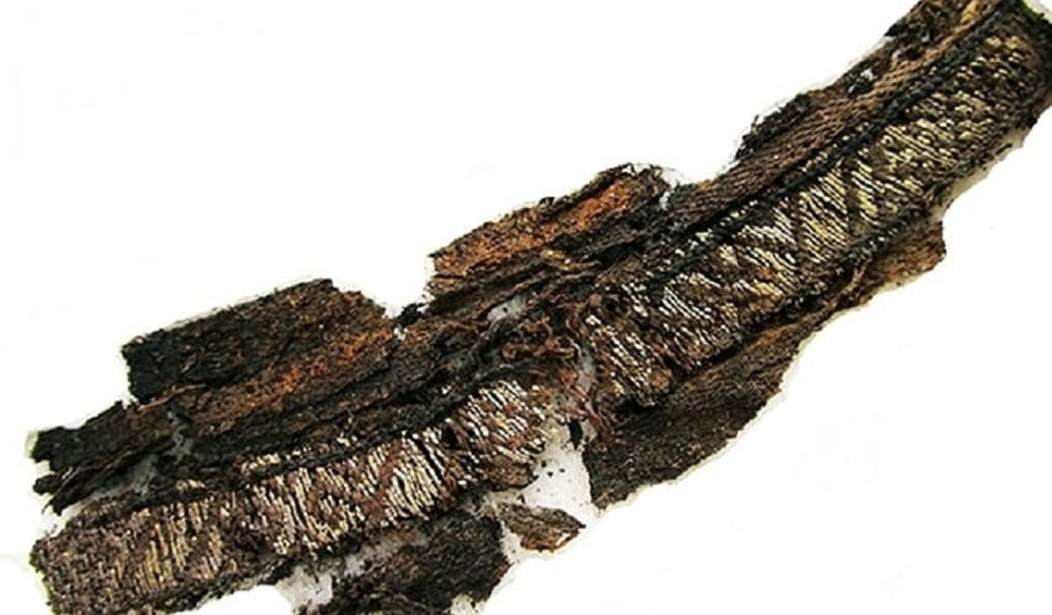
Image via Uppsala University http://www.uu.se/en/news-media/news/article/?id=9390&area=2,6,10,16,22,42&typ=artikel&lang=en
There is an fascinating story being flogged by the New York Times, and by ‘fascinating’ I mean ‘totally bullsh**,’ that alleges that the Vikings were culturally influenced by Islam. Here’s the story:
The discovery of Arabic characters that spell “Allah” and “Ali” on Viking funeral costumes in boat graves in Sweden has raised questions about the influence of Islam in Scandinavia.
The grave where the costumes were found belonged to a woman dressed in silk burial clothes and was excavated from a field in Gamla Uppsala, north of Stockholm, in the 1970s, but its contents were not cataloged until a few years ago, Annika Larsson, a textile archaeologist at Uppsala University, said on Friday.
Among the contents unearthed: a necklace with a figurine; two coins from Baghdad; and the bones of a rooster and a large dog.
Dr. Larsson discovered the Arabic characters in February, as she was preparing some of the items for an exhibition on Viking couture in Enkoping, Sweden. She had been trying to recreate textile patterns for the exhibits — by comparing motifs on the burial dress with a silk band found around the head of a skeleton in a Viking grave at Birka, Sweden — when she discovered Kufic characters of Arabic.
…
“My opinion is that those who wore the fabrics must have understood the symbolism,” said Dr. Larsson. “But certainly, the person who wove the fabrics could read and write and knew what the characters meant.”
…
“She had so much silk in her grave that she has fascinated me,” she added during a tour of the show at Enkopings Museum, northwest of Stockholm.“The Quran says that silk is worn in paradise, which together with the inscriptions on the ribbons can explain the widespread presence of silk in Viking graves,” Dr. Larsson said. “Viking burial customs were very likely influenced by Islam and the idea of an eternal life in paradise.”
You know what else can explain this? Vikings ranged far from Scandinavia. By the 9th Century AD, Vikings were serving in the bodyguard of the Emperor of the Eastern Empire. Their funerary customs, which included burying the dead with a dog and a rooster along with an ostentatious display of earthly goods was recorded by a Muslim traveler in the 10th Century.
Hmm a culture that subsisted on pillaging had stuff from other cultures? How the fuck did that happen?! https://t.co/0k86Bbh3Zv
— neontaster (@neontaster) October 16, 2017
There is actually zero in this find that makes the case the wearer had a clue that the hidden Arabic text was anything other than a design. And the idea that the Vikings got the idea of Valhalla from Islam is so bizarre that one can’t even laugh about it.
As someone with an undergrad degree in history (sorry guys, a STEM degree was not necessary to get a commission as an infantry officer) and some grad courses under my belt, I’ve been horrified to see history taken over by people who apparently are unfamiliar with their own discipline and critical reasoning and use the discipline to push an agenda. In this case, it is trying to build a narrative of the Vikings being heavily influenced by Islam in order to construct an argument that it is hypocritical of modern Scandinavians to not want to be overwhelmed by Islamic immigrants. Nevermind the cultural differences that have arisen in the intervening centuries.
A lot of historical research runs on two principles. First, it forgets the “absence of evidence is not the evidence of absence.” If you want a great example of how that oversight freakin set back the study of pre-Columbian America, read about the efforts of the proponents of the Clovis culture. Secondly, “post hoc ergo propter hoc” is not a logical fallacy but an organizing principle. For instance, for quite a long time it was axiomatic that trade routes in the Mediterranean followed the shoreline, that ancient sailors did not venture beyond sight of land (apparently, ‘hey, y’all, hold my beer and watch this’ was not a thing back then). Why did we believe that? Because all the shipwrecks were near the shore. Why was that? Well, rocks have a bad effect on ships and, most importantly, exploration was limited to areas that could be reached by divers. Now, with side scan sonar and other developments, we are discovering ancient wreck in very deep water in the Mediterranean and Black Sea. So fuzzy thinking was a significant problem for historians long before the SJWs decided to own the past.
What is the most egregious thing about this episode is that the proper path for academic arguments to be made is by publication in a peer reviewed journal followed by study and debate by experts in the field. That Larsson has elected to go the popular media route indicates there is less to her discovery that meets the eye. An actual authority on the subject has written an epic 60-tweet takedown of this story. Basically, the script alleged to be found in this grave did not exist for some centuries after the burial. The script does not say Allah. In fact, it doesn’t spell anything. It is not unusual to find Arabic script on Viking and Anglo Saxon artifacts as design elements. Buddha figurines have been found in Viking graves and, oddly enough, this discovery also contained coins minted in Baghdad. And on and on.
Here is that takedown, I mentioned above. This is how scholarship is supposed to work:














Join the conversation as a VIP Member